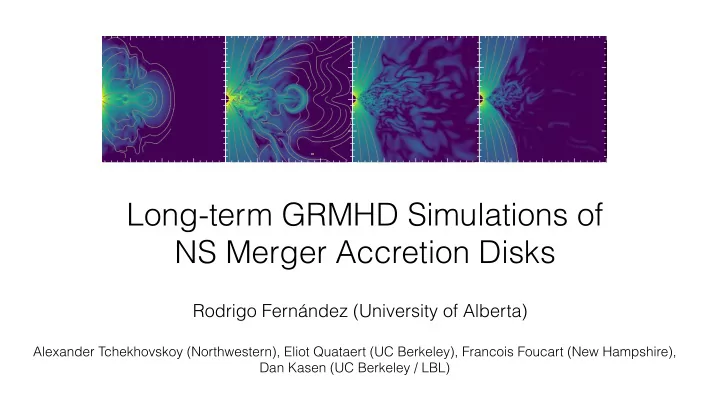

Long-term GRMHD Simulations of NS Merger Accretion Disks Rodrigo Fernández (University of Alberta) Alexander Tchekhovskoy (Northwestern), Eliot Quataert (UC Berkeley), Francois Foucart (New Hampshire), Dan Kasen (UC Berkeley / LBL)
Neutron Star Mergers RF & Metzger (2016)
Outflow from remnant accretion disk • Neutrino cooling shuts down as disk spreads on viscous timescale (~100-300ms) >> orbital time • Viscous heating & nuclear recombination are unbalanced • If BH at center, eject ~10-20% of initial disk mass, more if HMNS at the center • Material is neutron-rich (Ye ~ 0.2-0.4), mostly light r-process and some heavy, depending on parameters • Mass-averaged wind speed (~0.05c) is slower than dynamical ejecta (~0.1-0.3c) RF & Metzger (2013), MNRAS Lee, Ramirez-Ruiz, & Lopez-Camara (2009) Setiawan et al. (2005) Just et al. (2015), MNRAS RF et al. (2015), MNRAS Metzger (2009)
GRMHD 6 2 . 50 4 mag ) 2 . 25 log 10 β pl = log 10 ( P / P 2 Use HARM, extended to 3D and parallelized with MPI z [10 6 cm] 2 . 00 0 Parameterized neutrino cooling and nuclear -2 1 . 75 recombination, gamma-law EOS, Kerr metric -4 1 . 50 -6 Black hole mass: 3M sun , spin = 0.8 6 Start from equilibrium torus, constant Ye, entropy, 25 and angular momentum, M disk = 0.03M sun 4 20 2 λ MRI / ( r ∆ θ ) z [10 6 cm] 15 Impose strong initial poloidal field, fully resolve MRI in 0 equatorial plane 10 -2 5 Compare with hydro models with identical microphysics -4 0 -6 0 2 4 6 8 10 12 14 see also Siegel & Metzger (2017, 2018) x [10 6 cm] Shibata+ (2007,2012), Janiuk+(2013), Nouri+ (2017) RF , Tchekhovskoy, Quahaert, Foucart, & Kasen (2019)
1 0 . 5 0.5 0 . 4 Early evolution z [10 7 cm] 0 . 3 0 Y e 0 . 2 0 . 1 -0.5 0 10 Development of MRI starts accretion 0.5 5 z [10 7 cm] Γ [s � 1 ] 0 0 � 5 -0.5 Magnetic field winding and amplification � 10 launch outflow over the first few orbits t � 5 . 0 ms t � 10 ms t = 66 ms t � 230 ms 10 11 0.5 z [10 7 cm] T [K] 0 MRI heating increases entropy and 10 10 equilibrium Ye -0.5 10 30 p / 8 π [erg cm � 3 ] 0.5 10 29 z [10 7 cm] 10 28 0 10 27 10 26 -0.5 B 2 10 25 10 30 φ / 8 π [erg cm � 3 ] 0.5 10 29 z [10 7 cm] 10 28 0 10 27 RF et al. (2019) 10 26 -0.5 B 2 10 25 -1 0 0.5 1 1.5 0.5 1 1.5 0.5 1 1.5 0.5 1 1.5 2 x [10 7 cm] x [10 7 cm] x [10 7 cm] x [10 7 cm]
Outflow at r=10 9 cm Long-term mass ejection MHD outflow ejects twice more mass than equivalent hydrodynamic model 50% of the mass is ejected before 1s Late time behavior of MHD and hydro models is very similar: shared mass ejection mechanism RF et al. (2019)
(a) (b) (c) GRMHD 9.3s 10 � 3 Mass in bin [ M � ] 3.0s 1.0s 10 � 4 0.3s 0.1s Mass histograms 10 � 5 at r=10 9 cm 10 � 6 (d) (e) (f) 16.5s α = 0 . 03 10 � 3 3.0s Mass in bin [ M � ] Early ejecta is more 1.0s 10 � 4 neutron rich: imprint of initial disk composition 10 � 5 10 � 6 GRMHD model has (g) (h) (i) 8.8s α = 0 . 10 10 � 3 broader Ye distribution 3.0s Mass in bin [ M � ] 1.0s and faster average 10 � 4 0.4s velocity 10 � 5 10 � 6 10 1 10 2 10 3 10 � 3 10 � 2 10 � 1 10 0 0 . 0 0 . 1 0 . 2 0 . 3 0 . 4 Y e entropy [ k B /baryon] v r / c RF et al. (2019)
10 51 10 51 (a) total 10 50 kinetic energy in bin [erg] rest kin 10 49 em 10 50 10 48 thermal 10 47 More kinetic energy than 0 10 20 30 10 49 θ (deg) required to explain non- thermal emission from 9 . 3 s 10 48 GW170817 0 . 1 s 0 . 3 s 10 � 3 (b) 9 . 3 s mass in bin [ M � ] Dependent on initial 3 s 10 � 4 magnetic field geometry 1 s 0 . 3 s 10 � 5 0 . 1 s Powerful jet is obtained (c) 10 0 � γβ � at t = 9 . 3 s KE-weighted 10 � 1 mass-weighted RF et al. (2019) � 1 . 0 � 0 . 5 0 . 0 0 . 5 1 . 0 cos ( θ )
Summary 1. GRMHD disks can eject twice more mass than disks evolved in viscous hydrodynamics, have faster average speed and lower average Ye (depending on initial disk composition) 2. Two-component outflow: thermally-driven (MRI turbulence or viscosity) and magnetically-driven (Lorentz force) 3. More than sufficient kinetic energy to account for non-thermal emission from GW170817, but sensitive to initial field geometry Fernández, et al. (2019), MNRAS, 428, 3373 Thanks to:
Recommend
More recommend